| |
Glossary of Coral Reef Terminology - I
ichno - a prefix meaning "trace" |
ichnogenus - a genus based on the fossilized work of an organism |
ichnologist - a scientist whose area of study and research is ichnology |
ichnology - the branch of paleontology that deals with traces of organismal behavior. The division of ichnology dealing with trace fossils is paleoichnology, while neoichnology is the study of modern traces |
ichnospecies - a species based on the fossilized work of an organism |
ichnotaxon - a taxon based on the fossilized work of an animal, including fossilized trails, burrows, and tubes |
ichthyo- - pertaining to fishes |
ichthyochory - the dispersal of plant seeds or spores by fishes |
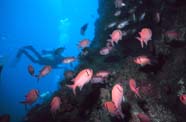
The diver is studying the behavior and ecology of squirrelfishes on a Caribbean coral reef. (Photo: Dr. Anthony R. Picciolo, NOAA)
|
ichthyology - the scientific study of fishes |
icon - a small picture displayed on a computer monitor that identifies a command or file. |
iconel tag - a metal tag that is attached to the trailing edge of a seaturtle's flipper to provide a means of unique identification |
iconotype - in taxonomy, a drawing or photograph of a type specimen |
icosahedral - a many sided, three dimensional, hexagonal shape made up of many small triangles |
ICRI (International Coral Reef Initiative) - an environmental partnership and network that brings all the stakeholders together with the objective of sustainable use and conservation of coral reefs for future generations. ICRI is an informal mechanism that allows representatives of over 80 developing countries with coral reefs to sit in equal partnership with major donor countries and development banks, international environmental and development agencies, scientific associations, the private sector and non-governmental organizations (NGOs) to decide on the best strategies to conserve the world's coral reef resources |
Icriforum - the official web site of the International Coral Reef Initiative (ICRI). Information relative to ICRI and its secretariat are available under this section, such as the current secretariat, the ICRI Meetings, the history of ICRI, and the ICRI Partners |
idiopathic - denotes a disease of unknown cause or origin |
IDL (Interactive Data Language) - a commercial array-oriented language with numerical analysis and display features, first released in 1977. It supports interactive reduction, analysis, and visualisation of scientific data |
igneous rock - a rock formed by the cooling and crystallization of molten magma |
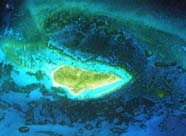
Four-meter true color IKONOS image of Buck Island Reef National Monument shows an extensive underwater coral reef ecosystem.
|
IKONOS satellite - high-resolution (1-2 meter resolution) imaging satellite; the world's first commercial satellite for imagery of this type |
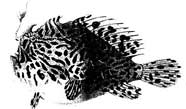
Illustration depicting the "fishing rod-like" appendage on the head of the above fish
|
illecium - a "fishing rod-like" appendage on the head of some fishes, usually a modified dorsal fin spine |
imagery - visible representation of objects and (or) phenomena as sensed or detected by cameras, infrared and multispectral scanners, radar, and photometers |
imbricate - with overlapping parts, such as scales |
imitation - a behavior that occurs when an animal immediately mimics the actions of another animal while they are in each other's presence |
immature - describes an animal that has not reached sexual maturity, regardless of size or age |
immersed corallite - a corallite that is embedded in the surrounding coenosteum |
immune system - a system that provides the organism with a defense against infection. In higher organisms it is afforded by the presence of circulating antibodies and white blood cells. Antibodies are manufactured specifically to deal with the antigens associated with different diseases as they are encountered. White blood cells attack and destroy foreign particles in the blood and other tissues |
immunogen - any substance that can elicit an immune response |
immunosuppressive compound - a compound that suppresses the body's immune system. Immunosuppressive compounds are medically important in cases of hypersensitivity to certain antigens or organ transplantations. A number of immunosuppressive molecules have been isolated from marine sponges |
impact - a change, caused by external sources, in the chemical, physical (including habitat) or biological quality or condition of a habitat or environment |
imperforate corals - corals which have solid skeletons with no connections between the polyps |
impermeable - having the property of restricting the passage of substances across a membrane |
imposex - the imposition of male characteristics on female organisms, as caused by some pollutants. For example, a pseudo-hermaphroditic condition in female gastropods (development of a false penis) caused by tributylin (TBT), a biocide used in anti-fouling paints |
imprimis - in the first place |
in adnot. - in an annotation (in adnotatio) |
in hospite - within the host |
in litt. - in correspondence or communicated in writing; used for an unpublished source of information (in litteris) |
in place organism - an organism that is permanently attached or fixed in position to a surface or substratum, such as a coral; a sessile organism |
in situ - in the natural or original position |
in situ data - measurements made at the actual location of the object or material measured, in contrast to remote sensing |
in situ hybridization - a method of detecting the presence of specific nucleic acid sequences within a cytological preparation. A DNA or RNA probe is labeled, radioactively or chemically, and hybridized to a cytological preparation to detect RNA, or to a denatured cytological preparation to detect complementary DNA. The hybridization is detected by autoradiography (for radioactive probes) or by chromogenic reactions or fluorescence (for chemically-labeled probes) |
in syn. - in synonymy (in synonymis) |
in vitro - a laboratory experiment or study performed outside the body of a living organism in a test tube, petri dish, or other vessel |
in vivo - studies conducted in intact living organisms or cells |
inbreeding - reproduction among closely related individuals |
inbreeding depression - a reduction in fitness and vigor of individuals as a result of increased homozygosity through inbreeding |
inc. sed. - of uncertain taxonomic position or affinities (incertae sedis) |
incidence - pertaining to disease, the number of new cases of a specific disease occurring during a certain time period, or number of diseased individuals in a population |
incident command system (ICS) - a management system used to organize emergency response. ICS offers a scalable response to an emergency (incident) of any magnitude, and provides a common framework within which people can work together |
incidental parasite - an accidental parasite |
incipient - beginning to exist or appear; beginner; beginning, starting, coming into existence |
incipient atoll - an atoll in its early stages of formation |
incipient population - a small population that is just beginning to reproduce and become established in an area or community |
incipient species - a geographically isolated population. With time, the accumulation of genetic differences in the incipient species population produces isolating mechanisms which inhibit the reproductive potential of the incipient population and its conspecific parent population |
incisiform tooth - a chisel-shaped tooth used for cutting. Typically, it wider than it is thick |
incomplete dominance - in genetics, an interaction between alleles in which both alleles are expressed more or less equally. The expression for a phenotype for a given trait exhibits a blending of the genetic messages from the allele partners controlling that trait. An example may be a cross between a homozygous red trait (AA) and a homozygous white trait (aa), where neither the red (A) nor white (a) trait is dominant. The phenotypic expression of the offspring is pink (Aa), the intermediate phenotype |
incomplete protein - a protein which does not supply all the essential amino acids |
incorporated territory - equivalent to Territory, a United States insular area, of which only one territory exists currently, Palmyra Atoll, in which the United States Congress has applied the full corpus of the United States Constitution as it applies in the several States. Incorporation is interpreted as a perpetual state. Once incorporated, the Territory can no longer be de-incorporated |
incubation - the period of time from when an egg is fertilized until hatching; the maintaining of eggs under conditions favorable for hatching; the time between exposure to an infectious organism and the appearance of clinical systems of disease |
incurrent canal - in sponges, an inpocket of the epidermis (pinacoderm) which opens into a choanocyte chamber via a small opening, the prosopyle |
independent assortment - the random alignment of homologous chromosomes during meiosis. Each member of a pair of homologous chromosomes separates independently of the members of other pairs so the results are random |
independent variable - a variable controlled by the experimenter |
indeterminate cleavage - cleavage where the fate of the resulting daughter cells is not determined after the initial divisionof a fertilized egg. If the cells separate, each has the potential to develop into an entire organism and the resulting individuals are genetically identical (identical twins). Inderterminate cleavage is characteristic of deuterostomes |
indicator species - any organism that by its presence or absence, its frequency, or its vigor, indicates a particular property of its surrounding environment; a species whose presence is a sign that certain environmental conditions exist |
indigenous - native to a particular country or area |
Indo-Pacific - a vast region encompassing the tropical Indian and Pacific Oceans from Africa in the west to Hawaii and French Polynesia in the east. This area represents the largest marine biogeographic region in the world |
inductive reasoning - the process of observing data, recognizing patterns, and making generalizations from the observations; reasoning from particular facts to a general conclusion |
inert - refers to unmoving or unchanging. In chemistry, a substance which does not or rarely combines with other substances. In medicine, it means a substance that has little or no effect on the human body |
infauna - animals that inhabit the sandy or muddy surface layers of the ocean bottom, i.e., those that live buried or dig into the substrate |
infection - the invasion of an organism's body tissues by disease-causing microorganisms, which may produce tissue injury |
infectious - capable of spreading disease |
infectious agent - an organism capable of spreading disease |
inference - a conclusion derived either by logical reasoning from premises and/or evidence, or by insight or analogy based on evidence |
inferior - anatomically beneath, lower, or toward the bottom (e.g., the mouth is inferior to the nose) |
inflammation - a nonspecific, localized protective immune response of tissues to irritation, injury, or infection, characterized by pain, redness, swelling, and sometimes loss of function. Inflammation may be acute or chronic |
inflated - swollen or expanded |
informatics - the management and analysis of data using advanced computing techniques |
information management - the integration of a variety of activities designed to manage information and information resources throughout their life cycle. Activities include planning, budgeting, organizing, directing, training, promoting, and controlling the information and information resources throughout the process of collecting, processing, transmitting, disseminating, and disposing of information; the manipulation, reorganization, analysis, graphing, charting, and presentation of data for specific management and decision-making purposes |
Information Technology (IT) - a very general term referring to the entire field of Information Technology - anything from computer hardware to programming to network management |
infra- - a prefix meaning "below" |
infrared scanner - an instrument that detects infrared radiation and converts the detected energy to an electrical signal for recording on another medium |
infrasonic - sound waves that have a frequency that is lower than what humans can hear (i.e. below about 20 hertz). Some baleen whales and elephants produce infrasounds to communicate over long distances |
infraspecific name - in taxonomy, a general term for any name below the rank of species. The term includes subspecific and infrasubspecific names |
infrasubspecific - in taxonomy, a category below the subspecies level |
infundibuliform - funnel-shaped |
ingestion - the intake of water or food substances by "swallowing" them, taking them into the body cavity or into a cell vacuole |
inhalant system - in sponges, part of the aquiferous system between the ostia and prosopyle |
injection well - a well constructed for the purpose of injecting a liquid, such as treated water, often wastewater, directly into the ground. Water is generally pumped, under pressure, into the well for dispersal or storage into a designated aquifer. Injection wells are generally drilled into aquifers that are not used as a drinking water source, unused aquifers, or below freshwater levels; a well in which a liquid is pumped down into the ground under pressure so that it passes from the well back into the pore space of the rock or regolith |
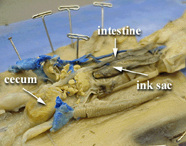
Ventral view of a dissected squid revealing the ink sac. (Photo: Biology Dept., Fairfield University, Fairfield, CT)
|
ink sac - a diverticulum of the rectum of most cephalopods, where an 'inky" melanin solution is stored. The ink is ejected from a duct opening at the base of the siphon. It serves to cloud the water, and enable these animals to escape from predators |
innate - not established by conditioning or learning; "an unconditioned reflex"; a genetic behavior pattern |
innate releasing mechanism - in ethology or animal behavior, an innate system within an animal that responds to a stimulus in the environment to produce a genetic stereotyped behavior; a stimulus-response mechanism |
inner cell mass - the cluster of cells inside the mammalian blastocyst. These cells give rise to the embryonic disk of the later embryo and, ultimately, to the fetus |
inorganic matter - chemical substances of mineral origin which contain no organically produced carbon |
inquilinism - a symbiotic association in which one symbiont lives in close association with another, generally in its shell, tube or burrow, or actually within a body cavity of the host |
inquilinism - a symbiotic association in which one symbiont lives in close association with another, generally in the tube or burrow or actually within a body chamber of the host |
inserted gene - a gene introduced into the DNA of a recombinant organism which is not present at the same position in the DNA of the organism before genetic modification |
insolation - the amount of solar radiation received on a given body or in a given area |
instar - a discreet, in-between molt stage, during the metamorphosis of an arthropod from larva to adult |
instinct - an unlearned, genetically coded behavior pattern that is internally motivated and characteristic of the species; the innate capacity of an animal to respond to a given stimulus in a relatively fixed way |
insular - relating to, or characteristic of, or situated on an island |
insular area - a jurisdiction that is neither a part of one of the several States nor a Federal district. This is the current generic term to refer to any commonwealth, freely associated state, possession or territory or Territory and from July 18, 1947, until October 1, 1994, the trust Territory of the Pacific Islands. Unmodified, it may refer not only to a jurisdiction which is under United States sovereignty but also to one which is not, i.e., a freely associated state or, 1947-94, the trust Territory of the Pacific Islands or one of the districts of the trust Territory of the Pacific Islands |
integer - a number without a decimal (0, 1, 25, 173, 1032, etc.). Integer values can be less than, equal to, or greater than zero |
integrated coastal zone management - the process of combining all aspects of the human, physical and biological aspects of the coastal zone within a single management framework |
Integrated Coral Observing Network (ICON) - As of October 2005, the coral research program at NOAA's Atlantic Oceanographic and Meteorological Laboratory (AOML) was titled the "Integrated Coral Observing Network" (ICON), rather than the Coral Reef Early Warning System (CREWS). ICON is focusing upon: (a) Integrating data from diverse independent sources into value-added products supporting research, modeling and management decisions with respect to Marine Protected Areas and other ecosystem approaches to management issues, (b) Consistency with Integrated Ocean Observing System (IOOS) and Coral Reef Ecosystem Integrated Observing System (CREIOS) goals and objectives, (c) International partnerships to enhance the global ICON network, (d) Facilitation of development and transition to operations of promising relevant in situ instrumentation (e.g., PAM-fluorometry, pCO2, acoustic and optical particle detection and size fractionation, and acoustic telemetry), and (e) The hand-off of responsibility for the in situ coral reef station network infrastructure to a NOAA operational line |
Integrated Ecosystem Assessment - a critical tool to enable NOAA’s ecosystem approach to management. An IEA is a synthesis and quantitative analysis of information on relevant physical, chemical, ecological and human processes in relation to specified ecosystem management objectives. IEAs focus not on collecting new observations or conducting new research, but on integrating existing datasets to produce more useful assessments, build ecological forecast models, and develop other ecological decision support tools |
integrated observing system - a planned, organized, and structured system of interoperable earth observing systems, which, when networked, provide an expanded range of capabilities satisfying user information and product needs. An integrated observing system holds some common goals and adopts common solutions to achieve them |
Integrated Ocean Observing System (IOOS) - IOOS is a system of systems that routinely and continuously provides quality controlled data and information on current and future states of the oceans and Great Lakes from the global scale of ocean basins to local scales of coastal ecosystems. It is a multidisciplinary system designed to provide data in forms and at rates required by decision makers to address societal goals |
intensity - pertaining to sound, the average amount of sound power (sound energy per unit time) which is transmitted through a unit area in a specified direction. The magnitude of the intensity is often referred to as the intensity, without specifying the direction from which the sound is travelling |
intention movement - an incomplete behavior pattern that provides information about the activity a particular animal is about to perform, and acts as a signal to others |
interannual - refers to a climatic process that re-occurs every three to ten years. El Niño is an example of a climatic process that re-occurs every 4-6 years |
interface - the common boundary between two substances such as a water and a solid, water and a gas, or two liquids, such as water and oil |
interference competition - competition in which one species prevents another from having access to a limiting resource |
interferon - a family of small proteins that stimulate viral resistance in cells |
interglacial period - a warm period between glacial epochs |
interleukin - a family of proteins produced naturally to stimulate an organism's immune system by stimulating the growth and activities of certain kinds of white blood cells |

Some experts believe that the "living fossil" genus Neopilina, an internally segmented mollusk in the class Monoplacophora, is an an evolutionary link between mollusks and other more obviously segmented invertebrates, such as annelid worms. (Graphic: BIODIDAC)
|
intermediate form - a fossil or modern species that possesses characters definitive of two or more different taxa, or that displays characters morphologically intermediate between two different taxa |
intermediate host - in a parasite's life cycle, it is a host organism in which a parasite undergoes a stage of asexual development |
intermittent spawning - spawning at intervals |
internal transcribed spacer (ITS) - a sequence of RNA in a primary transcript that lies between precursor ribosomal subunits and is removed by splicing when the structural RNA precursor molecule is processed into a ribosome. These sequences are coded by ribosomal DNA. Eukaryotic organisms have two internal transcribed spacers; ITS-1 is located between the 18S gene and the 5.8S gene, and ITS-2 is located between the 5.8S and the 28S gene. Ribosomal genes and spacers occur in tandem repeats that are thousands of copies long. The ITS region is widely used in molecular phylogenetics and taxonomy |
International Code of Botanical nomenclature (ICBN) - the set of rules and recommendations dealing with the formal scientific names that are given to plants. The ICBN applies not only to plants, as they are now defined, but also to other organisms traditionally studied by botanist |
International Code of Zoological Nomenclature (the Code) - in taxonomy, an authoritative document containing a system of rules and recommendations to be followed in giving a scientific name to an animal or animal group. It has been adopted by the International Congresses of Zoology (more recently the International Union of Biological Sciences) and is administered by the International Commission on Zoological Nomenclature. The most recent version of the Code is the Fourth Edition published in September 1999 and took effect on January 1, 2000; usually referred to as the "Code" |
International Commission on Zoological Nomenclature (ICZN) - the judicial body empowered to enforce and interpret the International Code of Zoological Nomenclature |
International Committee on Taxonomy of Viruses (ICTV) - a committee which authorizes and organizes the taxonomic classification of viruses. They have developed a universal taxonomic scheme for viruses and aim to describe all the viruses of living organisms |
International Coral Reef Action Network (ICRAN) - established in 2000, ICRAN is a global partnership of coral reef experts who are working to halt and reverse the decline of the health of the world's coral reefs. Made up of some of the world's leading coral reef scientists and conservation groups, ICRAN partners have created a globally integrated action plan to manage and protect coral reefs, based on recommendations from the International Coral Reef Initiative (ICRI). The International Coral Reef Action Network is a coordinated response to ICRI's urgent call to protect coral reefs. There are three main interlinked components of ICRAN: reef management, global coral reef monitoring and assessment , and communications and knowledge dissemination |
International Zoological Congresses - the legislative bodies responsible for the rules of the International Code of Zoological Nomenclature and for authorization of the activities of the International Commission on Zoological Nomenclature |
internesting - as it pertains to marine turtles, the interval between a successful nest and the next nesting attempt |
Internet Service Provider (ISP) - a company or organization that provides access to the Internet |
interoperability - the ability of two or more systems to exchange and mutually use information |
interorbital - the space between the eyes |
interoreceptor - a neurological receptor that is located within the organism's body and detects physiological changes, e.g. pH, temperature, chemicals in blood |
interpolated name - in taxonomy, a name placed within parentheses (after a generic name to denote a subgenus; after a genus-group name to denote an aggregate of species, or after a specific name to denote an aggregate of subspecies. Names used in this way are not counted as one of the names in a binomen or trinomen |
interradial - in fishes, between the rays (or spines), e.g. interradial pigment is pigment on the membrane between the rays. |
interradial canal - one of four branched ciliated canals in scyphozoan medusae that originates from the gastric pouches and move materials from the ring canal back toward the stomach and gastric pouches |
interradial membrane - in fishes, the tissue between the fin rays or spines |
interradial pigment - in fishes, interradial pigment is pigment on the membrane between the fin rays |
intersex - an organism which possesses a mixture of male and female characteristics |
intersexual - involving both sexes, male and female |
interspecific - between members of different species |
interspecific competition - competition between individuals of different species |
interspinous membrane - in fishes, the membrane between fin spines |
interstices - the openings or pore spaces in a rock, soil, and other such material |
interstitial - refers to the interstices or pore spaces in rock, soil, or other material subject to filling by water; fluid-filled spaces between cells in tissues |
interstitial fauna - animals that live in the spaces within sediment particles (interstitial spaces) |
interstitial water - water in the pore spaces of soil or rock |

Sea anemones crowd a rocky intertidal zone (Photo: Nancy Sefton)
|
intertidal zone - the region between the highest water line and the mean low tide level |
intertropical convergence zone - the zone of low pressure near the equator where the trade winds converge and create heavy convectional precipitation; also known as "intertropical front (ITF) |
intolerant organism - an organism (or species) that is not adaptable to human alterations to its environment and thus declines in number where alterations occur |
intranet - a private network inside an organization that uses the same kinds of software found on the public internet, but which is only for internal use |
intrasexual - involving only one of the sexes, male or female |
intraspecific - among members of the same species |
intraspecific competition - competition between individuals of the same species |
intratentacular budding - a type of asexual reproduction where daughter corallites grow from the inside wall of parent corallites, usually by division of the parent corallite |
intrinsic - belonging to a thing by its very nature; the essential nature or constitution of a thing; inherent; in and of itself |
intrinsic value - a value placed on the inherent qualities of a species, independent of its value to humans |
introgression - the movement or incorporation of genes from one population into another through hybridization followed by backcrossing. Usually refers to movement of genes from one species to another or among sub-species that have been geographically isolated then brought back together by changes in the species ranges or planting of exotic populations |
introgressive hybridization - the spread of genes of one species to another species through hybridization. The hybrids �are able to breed back into one of the parental populations. This allows the reintroduction of alleles that may have been lost during the speciation process |
intromittent organ - a copulatory structure employed by the males of species that practice internal fertilization to transfer sperm cells into the reproductive tube of the female, e.g., the clasper of a shark, skate or ray; penis; modified anal fin (gonopodium) of live-bearer fishes |
intron - DNA sequences that interrupt the protein-coding sequence of a gene; introns are transcribed into mRNA but the sequences are eliminated from the RNA before it is used to make protein; junk DNA; in eukaryotic cells, a sequence of DNA that is contained in the gene but does not encode for protein. The presence of introns "splits" the coding region of the gene into segments called exons |
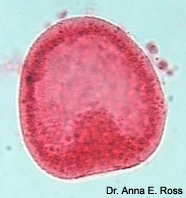
The cells at the vegetal hemisphere of this starfish blastula have begun to push into the blastocoel (invaginaton), forming a diploblastc embryo with a new cavity, the primitive gut, or archenteron. The cells lining the archenteron are endodermal cells. (Photo: Dr. Anna E. Ross, Christian Brothers University, TN)
|
invagination - an inward folding of a layer of cells forming an interior pocket |
invalid name - in taxonomy, any name for a given taxon other than the valid name |
inversion - a chromosomal re-arrangement that reverses the order of a linear array of genes on the chromosome |
invert - to turn inward; turn inside out or upside down |

Feathery invertebrate tube worms in the Caribbean Sea (Photo: Dr. Anthony Picciolo).
|
invertebrate - an animal that lacks a vertebral column (backbone) |
invertivore - an animal or plant that eats invertebrates |
investigative behavior - the sensory inspection of the environment |
involute - rolled inwards fom the edges |
ion - a positively or negatively charged atom produced through loss or gain of one or more electrons |
ion channel - a pore in a cell membrane, formed by an integral protein, that selectively regulates the diffusion of ions into and out of the cell. An ion channel switches between open and closed when the protein undergoes a conformational change. Ion channels are usually selective for a specific ion type (e.g., Na, or K, or Cl, or Ca) |
ionic bond - a chemical bond in which one atom loses an electron to form a positive ion and the other atom gains an electron to form a negative ion |
ionizing radiation - high-energy radiation capable of producing ionization in substances through which it passes, i.e., radiation that has enough energy to eject electrons from electrically neutral atoms, leaving behind charged atoms or ions; examples are alpha particles (helium nuclei), beta particles (electrons), neutrons, and gamma rays (high frequency electromagnetic waves, x-rays) |
ionocyte - a type of cell commonly found in the gills of fishes and some crustaceans. They play a role in regulating the salt concentration of cells in relation to the external environment, and differ greatly between freshwater and saltwater organisms; also called "chloride secretory cell" |
IOOS (Integrated Ocean Observing System) - a “user-driven” integrated system of observations, data management and communications, and data analysis and modeling that provides data and information required to achieve seven societal goals: 1) Improve predictions of climate change and variability (weather) and their effects on coastal communities and the nation; 2) Improve the safety and efficiency of marine operations; 3) More effectively mitigate the effects of natural hazards; 4) Improve national and homeland security; 5) Reduce public health risks; 6) More effectively protect and restore healthy coastal marine ecosystems; and 7) Enable the sustained use of marine resources |
IR (infrared) radiation - earth-emitted radiation over thermal wavelengths: 3-15 micrometers. Used for satellite remote sensing because it can be used to monitor weather and oceanographic conditions 24 hours a day |
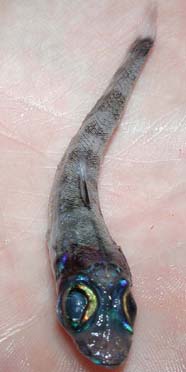
This deep-sea fish called a "green eye" (Chlorophthalmidae) exhibits a beautiful iridescent pattern around its large eyes and head. (Photo: NOAA Ocean Exploration)
|
iridescent - exhibiting rainbow colors |
iridiophore - a colorless chromatophore which contains purines, mostly guanine in the form of large, nonmotile crystals |
iron fertilization - see "ocean iron fertilization" |
isauxesis - equality in growth; isometry |
ischemia - a condition in which a tissue or organ does not receive a sufficient supply of blood |
island arc - a curved chain of islands that rise from the sea floor, usually near a continent. The convex side usually faces the open ocean, while the concave side usually faces the continent, e.g., the Aleutian Islands |
isobath - a line on a map or chart that connects all points having the same depth below a water surface |
isoenzyme - one of a group of enzymes that are very similar in catalytic properties, but may be differentiated by variations in physical properties, such as isoelectric point or electrophoretic mobility; also called 'isozyme' |
isogamous - having haploid gametes that are similar in size, structure and motility. An isogamete can unite with another to form a zygote |
isogenic chromosome - in a diploid organism, a chromosome in which both alleles at every locus are identical on both copies |
isohyetal line - a line drawn on a map or chart joining points that receive the same amount of precipitation |
isolecithal - an egg cell in which the total amount of yolk is small and the yolk granules are fairly uniformly distibuted throughout the cytoplasm, and cleavage completely bisects the cell, e.g., the egg of a starfish. A synonym is "homolecithal" |
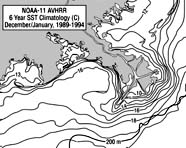
Isobars are utilized to depict NOAA-11 AVHRR SST climatology in this diagram.
|
isoline - a line on a surface connecting points of equal value |
isometric contraction - a muscular contraction in which tension increases while the length of the muscle remains constant |
isometric growth - growth that occurs at the same rate for all parts of an organism so that its shape is consistent throughout development |
isometry - change in overall size that maintains the same relative proportional shape |
isomorphic - having the same morphology for all stages of a life cycle |
isopleth - a general term for a line connecting points of equal value of some quantity. Isobars, isobaths,isotherms, etc. are all examples of isopleths; also called an isoline |
isorhiza - a form of cnidocyst (nematocyst) in which the tube is open and has the same diameter along its length. It responds to mechanical stimuli, and is also used in anchoring the animal when it walks on its tentacles |
isotonic contraction - a muscular contraction in which tension is constant while the length of the muscle changes |
isotope - one of two or more species of atoms of the same chemical element that have the same atomic number and occupy the same position in the periodic table. They are nearly identical in chemical behavior, but they differ in atomic mass or mass number. Therefore, they behave differently in the mass spectrograph, in radioactive transformations, and in physical properties, and may be separated or detected by means of these differences |
isthmus - a narrow strip of land connecting two larger land masses, such as the isthmus of Panama |
ITCZ (Intertropical Convergence Zone) - the region near the equator where the trade winds of the Northern and Southern Hemispheres converge |
iteroparity - the reproductive condition in which individuals reproduce several times during their lifetime |
iteroparous - a life history in which individuals reproduce more than once in a lifetime |
ITIS (Integrated Taxonomic Information System) - a partnership of U.S., Canadian, and Mexican agencies, other organizations, and taxonomic specialists cooperating on the development of an online, scientifically credible, list of biological names. ITIS is also a participating member of Species 2000, an international project indexing the world's known species |
IUCN (International Union for the Conservation of Nature and Natural Resources) - the world’s largest conservation network. The Union brings together 82 States, 111 government agencies, more than 800 non-governmental organizations (NGOs), and some 10,000 scientists and experts from 181 countries in a unique worldwide partnership. The Union’s mission is to influence, encourage and assist societies throughout the world to conserve the integrity and diversity of nature and to ensure that any use of natural resources is equitable and ecologically sustainable. IUCN is a multicultural, multilingual organization with 1000 staff located in 62 countries. Its headquarters are in Gland, Switzerland. ” Since 1990, the IUCN has been known as the "World Conservation Union" but the full name and the acronym are often used together as many people still know the Union as IUCN |
IUCN Categories I-VI - in the IUCN classification system for protected areas, Categories refer to higher levels of protection: Category I - Strict Nature Reserve/Wilderness Area: protected area managed mainly for science or wilderness protection; Category la - Strict Nature Reserve: protected area managed mainly for science; Category Ib - Wilderness Area: protected area managed mainly for wilderness protection; Category II - National Park: protected area managed mainly for ecosystem protection and recreation; Category 111 - Natural Monument: protected area managed mainly for conservation of specific natural features; Category IV - Habitat/Species Management Area: protected area managed mainly for conservation through management intervention; Category V - Protected Landscape/Seascape: protected area managed mainly for landscape/seascape conservation and recreation; Category VI - Managed Resource Protected Area: protected area managed mainly for the sustainable use of natural ecosystems |
|
|
|
|

